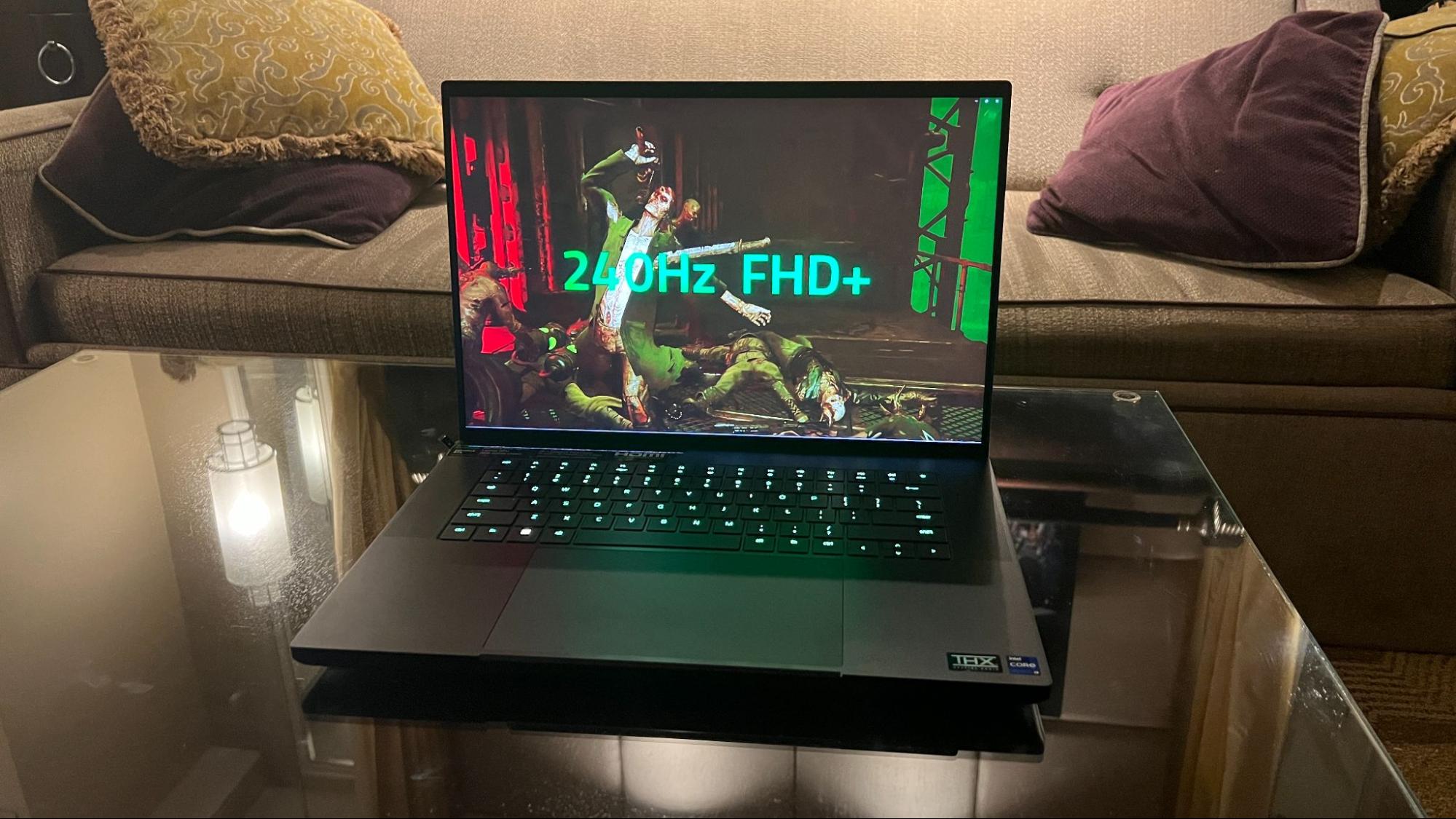Razer's 2023 Blade Laptops Sport 16:10 Screens, Latest GPUs
The Blade 16 will sport a "dual-more Mini-LED display" that switches from 4K+ 120 Hz to FHD+ at 240 Hz for gaming.
In line with what is clearly a 2023 trend for gaming laptops, Razer's latest blades sport taller 16:10 displays, which also bumps the diagonal dimension of the displays up an inch.
Razer is touting a nebulous "up to 35% more graphics power per cubic inch" metric, with "Nvidia's GeForce next-gen laptop GPUs" alongside Intel's new 13th Gen Core i9 HX CPU, with 24 cores and up to 5.6 GHz clock speed.
Every configuration of the 16-inch model will use an Intel Core i9-13950HX, but GPUs will range from the RTX 4060 to the RTX 4090. The laptops will start at 16GB of RAM and 1TB of storage, with the most expensive configurations packing 64GB of memory and a 2TB SSD.
The display is also a focus on the Blade 16, offering what Razer is calling the world's first dual-mode Mini-LED display. This gives you 4K+ (given the aspect ratio, that's likely 3840x2400) resolution at 120 Hz for "creative" applications, while in "gamer" mode, the screen switches to a "native" FHD+ (1920x1200) resolution at 240 Hz. With the Mini-LED backlight, comes 1,000 nits of peak brightness and 100% of the DCI-P3 color gamut.
The Blade 16 is also barely bigger than its 15 predecessor, with Razer touting a less than 1 cm increase in the front-to-back dimension, to accommodate the taller display. The laptop also sports a new 95.2 Wh battery, up from the max of 80 Wh on the Blade 15, and includes a 330W GaN charger.
Razer will offer the Blade 16 in a number of configurations, starting at $2,699 – $200 more than the current starting price of the now last-gen Blade 15 configurations.
If you are willing to trade portability for more graphics power and screen size, then the Blade 18, which Razer says will start at $2,899, might be more your speed. It will also of course sport Nvidia's latest-gen laptop graphics, from the RTX 4060 to the RTX 4090, and Razer says the Blade will deliver the maximum TGP (max power envelope) of all GPU options, as well as max TDP on Intel's 13th Gen Core i9-13950HX CPU. This should lead to about the best gaming performance you can get on a laptop, at least without overclocking – although we will of course have to test that once we get one in for review.
To achieve this level of performance (we imagine the top-end 40-series graphics chips will be quite thermally demanding, if the desktop models are anything to go by), Razer has actually increased its chassis size a bit, making the Blade 18 0.86 inches thick (up from 0.78 in the Blade 17).
The 18-inch screen on the Blade 18 is QHD+ (2560x1600) resolution 240 Hz panel, with no mention of a 4K+ option. In fact, Razer says this panel will come with all models of the Blade 18, despite configuration. While that may be disappointing to some, it's likely down to the shift to the 18-inch 16:10 panel, which is still quite new but seems to be a trend that's becoming commonplace quickly in the gaming laptop space. So we'd expect more screen options next year, if not later in 2023 in refresh as more 16:10 panel options hit the market.Razer is strongly emphasizing the Blade
18 as a desktop replacement. And as such, the company says the laptop will be upgradeable, although the company didn't detail the extent of this. We know it starts with 16GB of RAM, but can max out at 64GB, while storage will start at a 1TB SSD, but there's an open second slot. If you were to fill both SSD slots yourself, you could have 8TB of storage in this laptop.
Both the Blade 16 and Blade 18 are set for "Q1 2023" releases.
Get Tom's Hardware's best news and in-depth reviews, straight to your inbox.
After a rough start with the Mattel Aquarius as a child, Matt built his first PC in the late 1990s and ventured into mild PC modding in the early 2000s. He’s spent the last 15 years covering emerging technology for Smithsonian, Popular Science, and Consumer Reports, while testing components and PCs for Computer Shopper, PCMag and Digital Trends.
-
Sleepy_Hollowed Wow, these are monster laptops, as long as you only want to run either windows or linux with a brick.Reply
I wish they came with AMD option for CPU and GPU to double up as efficient workstation, but then g-sync and those refresh rates might not work, but dang, anyone on the wintelvidia camp will be getting a beast with these. -
_Shatta_AD_ Damn USD$2899 for a RTX 4060 model with probably 1TB SSD and 16/32GB RAM. If you live in Canada for example, that’s CND$3400 pre-tax. So a measly RTX 4080 model with 2TB SSD and 32/64GBRAM will probably cost USD$3799 which is close to CND$5700 post tax for a freaking gaming laptop that’s not portable and needs a wall outlet 24/7. You might as well build yourself a 7900XTX/RTX 4090 desktop unit with way more peripherals and 2x4TB SSDs for the same price?Reply


